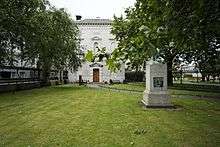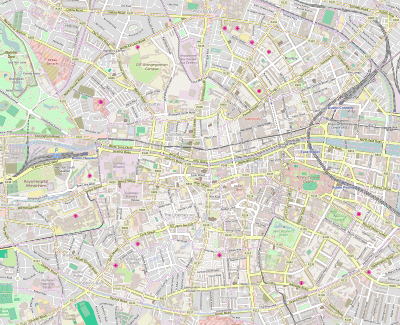Natural History Museum (Ireland)
| Ard-Mhúsaem na hÉireann - Stair an Dúlra | |
 Entrance to the museum | |
 Location of the museum in Dublin | |
| Established | 1856 |
|---|---|
| Location |
Merrion Street Dublin 2 Ireland |
| Coordinates | 53°20′23″N 6°15′11″W / 53.33976°N 6.252997°W |
| Type | National museum |
| Visitors | 108,615 (2007)[1] |
| Curator | Nigel Monaghan (Keeper) |
| Public transit access |
St Stephen's Green Dublin Pearse Dublin Bus routes: 7, 7A, 10, 11, 13, 172 (MuseumLink) |
| Website | museum.ie/en/intro/natural-history.aspx |
| National Museum of Ireland network | |
Ireland's Natural History Museum (Irish: Músaem Stair an Dúlra), sometimes called the Dead Zoo[2][3] a branch of the National Museum of Ireland, is housed on Merrion Street in Dublin, Ireland. The museum was built in 1856 for parts of the collection of the Royal Dublin Society and building and collection were later passed to the Irish State.
The Museum's collection and building have changed little since Victorian times, and it is sometimes described as a "museum of a museum".
Collection
The building is a ‘cabinet-style’ museum designed to showcase a wide-ranging and comprehensive zoological collection, and has changed little in over a century. Often described as a ‘museum of a museum’, its 10,000 exhibits provide a glimpse of the natural world that has delighted generations of visitors since the doors opened in 1857.
As the collection is unique in range and vintage, the exhibits are a product of their age, with faded and worn pelts and visible marks from bullets and rough taxidermy. Larger specimens are displayed in large, wood-framed glass cases while smaller ones are kept under glass, protected from sunlight by moveable leather panels. The main room is heated by an underfloor system similar to a Roman hypocaust.
The Irish Room, the ground floor of the museum, displays Irish animals, notably several mounted skeletons of giant Irish deer. Numerous skulls of those and other deer line the walls. Stuffed and mounted mammals, birds, fish — and insects and other animals native to or found in Ireland — comprise the rest of the ground floor. Many of the specimens of currently extant animals, such as badgers, hares, and foxes, are over a century old. A basking shark hangs from this ceiling.
The First floor contains mammals from around the world, including extinct or endangered species including a thylacine, a quagga, and a pygmy hippopotamus.
The Lower gallery, currently closed, contains bird specimens from around the world. Above this, the second ceiling suspends a humpback whale skeleton. This floor includes a composite dodo skeleton, from Mauritius.
The Upper gallery, also closed at present, displays invertebrate and marine specimens including the Museum's collection of models made by Leopold and Rudolf Blaschka.
As with many other natural history museums, a large number of specimens are not on display, for example the geological collections. Amongst other scientists who have studied the collections, Stephen Jay Gould did an extensive study of the specimens in the museum.
History
The Natural History building was built in 1856 to house the Royal Dublin Society’s growing collections, which had expanded continually since the late 18th century (the Society purchased one of Europes largest natural history collections, that of Nathaniel Gottfried Leske in 1792).
The building and its displays reflect many aspects of the history and development of the collections. It was originally built as an extension to Leinster House, where the Royal Dublin Society was based for much of the 19th century. The building was designed by architect Frederick Clarendon in harmony with the National Gallery of Ireland on the other side of Leinster Lawn. The foundation stone was laid on 15 March 1856 and the building was completed in August 1857 by contractors Gilbert Cockburn & Son. It formed an annexe to Leinster House and was connected to it by a curved closed Corinthian colonnade.
A bronze statue of Surgeon-General Thomas Heazle Parke stands in front of the Victoria-era building.
In 1877 ownership of the Museum and its collections was transferred to the state. New funding was provided for the building, and new animals were added from an expanding British empire during the great days of exploration.
In 1909 a new entrance was constructed at the east end of the building facing Merrion Street. This reversed the direction from which visitors approached the exhibitions and explains why some of the large exhibits still face what appears today to be the back of the building: it was too difficult to turn the whales and elephants around to face the new entrance.
Stairway collapse
On the morning of 5 July 2007, the 150-year-old Portland stone staircase (not accessible by the general public) gave way. Eleven people were injured,[4] as a teacher training course was underway in the area.
The stairway was a very ornate structure, arising from Leinster House's former status as the home of the Royal Dublin Society. Members of same would have used what is now the back door of the museum building to gain access from Leinster House to this building, hence the grandeur of the stairway.
The building was subsequently the subject of a Health and Safety review, and following this, plans for improvements were made, which have been partially implemented. This building was closed until Thursday 29 April 2010, when the ground and first floor were opened. The two galleries remain closed.
References
- ↑ http://www.arts-sport-tourism.gov.ie/culture/attendance_figures.html
- ↑ Clerkin, Paul. "Natural History Museum, Merrion Square, Dublin". Architecture of Ireland. Archiseek. Retrieved 2009-05-28.
- ↑ Hoque, Abeer (2006-05-27). "Notes on Dublin". The Daily Star. Retrieved 2009-05-28.
- ↑ "11 injured as museum staircase collapses". RTÉ News. RTÉ. 2007-07-05. Retrieved 2009-05-29.
External links
- Official website
- Collections Research
- RTE radio 1: Chopped, Pickled and Stuffed RTÉ produced and broadcast a 12 programme series for radio, entitled "Chopped, Pickled and Stuffed", exploring different aspects of the museum's collection.
- Flickr Photos of the Museum
- A radio report about the Dodo specimen is available